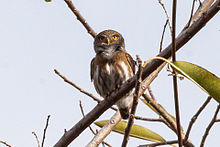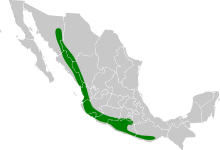| Colima pygmy owl | |
|---|---|
 | |
| Scientific classification | |
| Kingdom: | Animalia |
| Phylum: | Chordata |
| Class: | Aves |
| Order: | Strigiformes |
| Family: | Strigidae |
| Genus: | Glaucidium |
| Species: | G. palmarum |
| Binomial name | |
| Glaucidium palmarum Nelson, 1901 | |
 | |
The Colima pygmy owl (Glaucidium palmarum) is a species of owl in the family Strigidae.It is endemic to the western part of Mexico. Its habitat consists of tropical deciduous and tropical lowland evergreen forests. The Colima pygmy-owl is very small, have a spotted rounded head and long tails. It has a pair of prominent black marks (false eye spots) on its nape to protect itself. This species preys on large arthropods and very small vertebrates. They are distinguished by their song which has 24 notes, the first one being the longest and is a hollow hooting sound.[2]
American naturalist Edward William Nelson described the Colima pygmy owl in 1901.
This species is now widespread but was known as a subspecies for many years because it is so closely related to many other species in the owl family.
References
- ^ BirdLife International (2012). "Glaucidium palmarum". IUCN Red List of Threatened Species. 2012. Retrieved 26 November 2013.
- ^ Schulenberg, Thomas S. "Colima Pygmy-Owl Glaucidium palmarum - Introduction". Neotropical Birds. Retrieved 2019-10-18.
